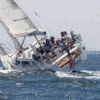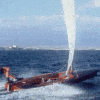Learning how to sail: Where do you start? – words Al Woods
Wouldn’t it be lovely to be able to charter a sail boat in the summer holidays and experience the freedom of being on the water? If you’re dreaming of sailing in the Caribbean, the Mediterranean or even The Solent, but you’ve never sailed before, here are 4 basic tips on how to get started with learning how to sail. Who knows, it could be the beginning of a lifelong love affair with the sea.
-
Know your sailboat
It’s important to know the different parts of the boat and some manoeuvres. If you’re not sure what to do when somebody shouts ‘Watch the boom!’ or ‘Prepare to tack’ you could be in trouble.
Here’s a list of some essential sailing vocabulary you’re going to have to manage:
Boom The horizontal beam at the foot of the mainsail. You want to watch out for this when the boat changes direction
Bow The front of the boat
Centreboard The fibreglass plate at the bottom of the keel used to balance the boat when sailing
Hull The body of the boat, consisting of everything below the deck
Halyard Lines that raise or lower the sails
Jib The sail at the bow of the boat, helping propel the boat forward
Mainsail Yes, it’s the main sail and it’s attached to the back of the mast
Keel This stabilises and prevents the boat from sliding sideways in whatever way the wind is blowing
Mast The large, vertical pole or poles that hold the sails up
Tacking This is a manoeuvre where the bow of the boat is steered through the wind so that the wind switches from one side of the boat to the other
Jibing This is the opposite of tacking, where you steer the stern of the boat through the wind so that the wind shifts to the other side of the boat – a tricky and dangerous manoeuvre
Tiller A stick attached to the rudder
Rudder The rudder is how the boat is steered. When you turn the wheel or tiller, the rudder directs the boat in the right direction
Spinnaker The large brightly coloured sail used when sailing across the wind or downwind
Stays and Shrouds These are wires or ropes that keep the mast upright
Stern This is the term for the back of the boat
Winch Winches help tighten the sheets and halyards
-
Sailing courses
If you’re really keen to learn how to sail, then you should enrol in a training course in the UK. You can also attend a course as part of a holiday, for instance in the Mediterranean. Courses are organised by the Royal Yachting Association (RYA).
RYA qualifications you can obtain include Start Yachting, Day Skipper Practical, the Competent Crew Certificate, and the International Certificate of Competence. Prices vary depending on where you take the course. A Day Skipper course, for instance, costs around £450 in the UK and around £500 to £600 in the Med, depending on the season.
Once you have the basic skills, you and your family and friends can join a flotilla – typically, 5 to 10 yachts – with an experienced skipper leading the way. The skipper holds daily briefings and all the boats are linked via radio and mobile phone. The good news is you need less experience for a flotilla sailing holiday where a skipper is provided, than a bareboat charter where you are the skipper.
-
Know your engine
Because strong sailing winds cannot always be guaranteed, it is vitally important for a yacht to have an engine. If you become becalmed and need to use engine power, you have to know something about boat engines.
When and if the wind dies altogether, the sensible course of action is to start the engine, take down the sails and slowly chug back to the safety of port. Although it’s highly unlikely that you’ll lose wind power, it’s just as well to be prepared.
-
What’s next, Skipper?
Your goal should be to obtain a Day Skipper certificate as soon as possible, and once you do, you can then charter a boat on a ‘bareboat’ basis. This means you can sail independently of a crew or a skipper.
It is always wise to check the weather conditions before setting sail on each and every journey. Make sure you steer clear of any forecasted strong winds or stormy conditions. If while you’re sailing the wind starts to build and storm clouds appear, take the safe option and steer your way out of it by tacking back into port.
Learning how to sail: Where do you start? – words Al Woods























